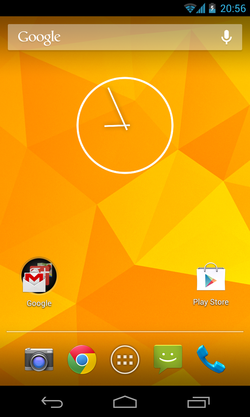
Back أندرويد جيلي بين Arabic Android Jelly Bean Catalan ئەندرۆید جێڵی بین CKB Android Jelly Bean Czech Android Jelly Bean German Android Jelly Bean Greek Android Jelly Bean Spanish اندروید آبنبات ژلهای Persian Android Jelly Bean French אנדרואיד ג'לי בין HE
| Version of the Android operating system | |
 | |
 Android 4.2 Jelly Bean running on a Nexus 4 | |
| Developer | |
|---|---|
| Released to manufacturing | July 9, 2012 |
| Final release | 4.3.1_r2 (JLS36I)[1] / October 4, 2013[2] |
| Kernel type | Monolithic (Linux) |
| Preceded by | Android 4.0.4 "Ice Cream Sandwich" |
| Succeeded by | Android 4.4 "KitKat" |
| Official website | www |
| Support status | |
| Unsupported since January 31, 2021 Google Play Services support dropped since August 2021[3] | |
Android Jelly Bean (Android 4.1, 4.2, 4.3) is the codename given to the tenth version of the Android mobile operating system developed by Google, spanning three major point releases (versions 4.1 through 4.3.1). Among the devices that launched with Android 4.1 to 4.3 are the Nexus 7 (2012), Nexus 4, Nexus 10, Nexus 7 (2013), and Hyundai Play X.
The first of these three releases, 4.1, was unveiled at Google's I/O developer conference in June 2012. It focused on performance improvements designed to give the operating system a smoother and more responsive feel, improvements to the notification system allowing for expandable notifications with action buttons, and other internal changes. Two more releases were made under the Jelly Bean name in October 2012 and July 2013 respectively, including 4.2—which included further optimizations, multi-user support for tablets, lock screen widgets, quick settings, and screensavers, and 4.3—which contained further improvements and updates to the underlying Android platform. The first device with Android Jelly Bean was the 2012 Nexus 7.
As of October 2022[update], 0.36% of Android devices run Jelly Bean.[4] In July 2021, Google announced that Google Play Services would no longer support Jelly Bean after August of that year.[5][6]
- ^ "Android Source". Google Git. Archived from the original on July 31, 2023. Retrieved May 28, 2021.
- ^ Hristov, Victor (October 4, 2013). "Android 4.3.1 update surprises Nexus 7 2013 owners, rolling out now". PhoneArena. Retrieved June 6, 2024.
- ^ "Google Play Services deprecates Android Jelly Bean support". ZDNet. Archived from the original on August 15, 2022. Retrieved August 15, 2022.
- ^ "Mobile & Tablet Android Version Market Share Worldwide - September 2020". StatCounter Global Stats. Archived from the original on July 14, 2020. Retrieved September 22, 2019.
- ^ Duckett, Chris (July 8, 2021). "Google Play Services deprecates Android Jelly Bean support". ZDNet. Archived from the original on August 15, 2022. Retrieved August 15, 2022.
- ^ Kansal, Vikas (July 8, 2021). "Google Play services discontinuing updates for Jelly Bean (API levels 16, 17 & 18)". Android Developers Blog. Archived from the original on July 10, 2022. Retrieved August 15, 2022.